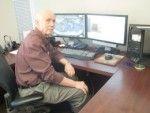Energy conservation is on the rise, and new software and technology at Texas A&M is making energy reduction an easier, more common practice than ever before.
Instrumental in this process is the Energy Systems Laboratory at A&M, where researchers work toward reducing a building’s energy use, maintaining current equipment quality, and improving the quality of life for others.
Charles Culp is a professor in the Department of Architecture and teaches energy efficiency courses. He also is an associate director of the ESL, a division of the Texas A&M Engineering Experiment Station.
The ESL is a large university lab, Culp said, with 50 full-time staff members. The lab also employed more than 88 students last year.
Here Culp works, along with his colleague David Claridge, the director of the Energy Systems Lab, and many other employees and students, on reducing energy consumption in large-scale buildings through the Continuous Commissioning® process, or CC®. During the process, engineers focus on how the building wastes energy, especially in the heating & cooling systems, which can then be optimized for greater energy conservation.
The process of energy reduction is being improved through the CC® software. The creation of this technology is credited to Claridge, but Culp and engineers such as Kevin Christman, research engineering associate at the Energy Systems Laboratory and Class of 2010, remain integral to the process.
Christman said the first step in the process is to decide which buildings require the most energy to maintain a comfortable atmosphere and if the structure is a good candidate for energy conservation.
“Figuring out how to fix the building’s problems takes an expert,” Christman said. “You can’t just go by which building uses the most energy, because maybe that building has special needs like a lot of fresh air from the outside due to it being a hospital, chemical lab, et cetera. Or maybe at night they have a night school. So we have developed a tool called ‘Opportunity Assessor,’ which helps identify ‘high opportunity’ buildings.”
After a building is identified, the second step comes into play – WinAM, which calibrates the actual data with the predictions made by the software.
“WinAM helps engineers create a model of the building, which we use to estimate how much money we think we’ll save the building,” Christman said.
The third and final step is Implementer, which allows members of the ESL lab to find specific issues in the field. After the problems are remedied, Christman said, the actual results of the program can be evaluated.
“Once we are done finishing the building, we set up a measurement effort to look at utility bills and we compare them to the previous year’s bills,” Christman said. “Obviously there are going to be changes from year to year because of weather and outside factors, but we can ultimately show the building owner how much money they have saved.”
With this software, the ESL has saved businesses thousands of dollars in utility bills with a short one to two-year payback period.
“We go into buildings typically with 50,000 square feet and bigger,” Culp said. “Either we or our licensees will reduce the energy consumption by 10-20 percent with a two-year pay back. That’s like taking your retirement money and getting a 50 percent interest rate.”
Hillary Cowan, senior environmental design major, said she believes it is very important to focus on feasible conservation methods throughout the nation. While traveling in Europe, Cowan said she noticed institutionalized methods for reducing energy consumption.
“In some places in Europe they have a set time where they want people to turn off their lights so that the bulk of energy is consumed during the day and not all night too,” Cowan said. “Energy is a precious commodity.”
Culp said that in the end, conservation and concerns with energy consumption lie in the hands of students. ESL, therefore, is modeled after the teaching hospital concept, providing education and practical application of skills in the same program.
“In hospitals, doctors do innovative work and develop new techniques which they then train other doctors to do so that they can practice that new medicine,” Culp said. “We do the same thing; there are a lot of similarities because we are so student focused. We take our students out into the real world for hands-on experience and after they work here they are ready to take off on their own future careers.”
Researchers develop technology to reduce energy consumption
June 12, 2013

Donate to The Battalion
Your donation will support the student journalists of Texas A&M University - College Station. Your contribution will allow us to purchase equipment and cover our annual website hosting costs.



















